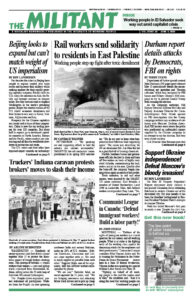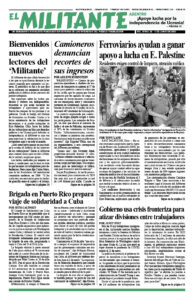For decades the rulers in Beijing have sought to expand control over trade routes and increase their military while seeking markets for their rapidly growing capitalist economy. Rivalry with the U.S. rulers for influence in Asia, the Pacific and beyond continues to sharpen today. But they have no road to displace Washington as the world’s prevailing power, despite the relative erosion of the U.S. rulers’ economic dominance and their failure to win wars in Korea, Vietnam, Afghanistan and Iraq.
Prospects for the Chinese capitalists are closely tied to those of their competitors. China is now the top trading partner for over 120 countries. But about half its exports go to developed capitalist countries in North America, Europe and the Pacific, where markets are contracting and all face the worldwide slowdown in production and trade.
The U.S. rulers and their allies have imposed export controls on technology to China, citing concerns that it will be used by Beijing to enhance its military. These measures also curb economic growth in China.
Over several decades Beijing opened its economy to international capital and export markets. Across China hundreds of millions of peasants were pushed to migrate to cities to provide a pool of cheap labor. As the economy expanded 15-fold in the two decades leading up to 2021, vast wealth accumulated in the pockets of foreign and state-backed domestic capitalists.
Washington and other imperialist powers abandoned hope that this giant expansion, now slowed, would boost profits, and stabilize the world order they preside over. Instead, Beijing is now seen by them as a dangerous rival. Tensions between it and Washington have escalated since Moscow’s invasion of Ukraine.
The Chinese rulers are grappling with how to lessen their reliance on export-driven growth by boosting the home market. But their own Stalinist-trained, capitalist-minded regime has long held down wages.
Tens of millions of urban migrant workers are excluded from state benefits like health care and schooling. China’s internal consumption per capita is $8,700 a year, substantially lower even than South Korea, Taiwan and Singapore. China’s working-age population has been contracting since 2012 and its total population is now declining for the first time in 60 years. Youth unemployment has reached over 20%.
Local governments and state-run corporations are weighed down by colossal debts. Decades of loans for infrastructure projects have been swollen by the cost of brutal pandemic quarantine measures imposed by Beijing. About a third of China’s major city authorities can barely pay the interest, let alone the principal, on their debts.
Workers and farmers have taken to the streets in unprecedented numbers recently to protest unpaid wages and cuts to retirement funds and public services.
Belt and Road runs into problems
The Belt and Road Initiative, dubbed by China’s President Xi Jinping as the “project of the century,” made Beijing the world’s largest lender to semicolonial countries. The network of infrastructure and trade links was meant to boost the profits and political influence of Chinese capitalists.
But it has lost momentum. In many Chinese-financed projects, from Latin America to Africa and Asia, overpricing, allegations of graft and construction flaws have plagued these mega-projects.
Chinese-built hydroelectric plants, touted as a means to fill the needs of millions for electrical power, have dangerous defects. Officials in Pakistan shut down the Neelum-Jhelum hydroelectric plant last year — concerned that its tunnels would collapse — just four years after it opened. Over 17,000 cracks found since 2016 in the Chinese-built Coca Coda Sinclair dam in Ecuador have proved to be unrepairable.
As the global capitalist crisis bites, many semicolonial nations struggle to repay debts incurred to finance Beijing-funded projects. In case of default, Beijing can seize facilities, as with Sri Lanka’s port of Hambantota.
In the Asia-Pacific region, Beijing’s military expansion and aggressive moves include the fortification of artificial islands in the disputed South China Sea, strangling political rights in Hong Kong, and threats to invade self-ruled Taiwan. Washington threatens to respond militarily to any aggression against Taiwan.
The U.S. rulers have unmatched military might and have strengthened their alliances with imperialist powers like Japan and Australia, and with the governments of India, South Korea, Vietnam and the Philippines, to counter Beijing’s growing military clout.
Amid this intensifying competition no other capitalist power is anywhere near to having a currency that can challenge the dollar’s status as the world’s reserve. The greenback accounted for 60% of global currency reserves at the end of last year, in contrast to the euro’s 20%. Trade in the yuan accounted for less than 3%.

